|
BULB LOG 09 -- 1st March 2006
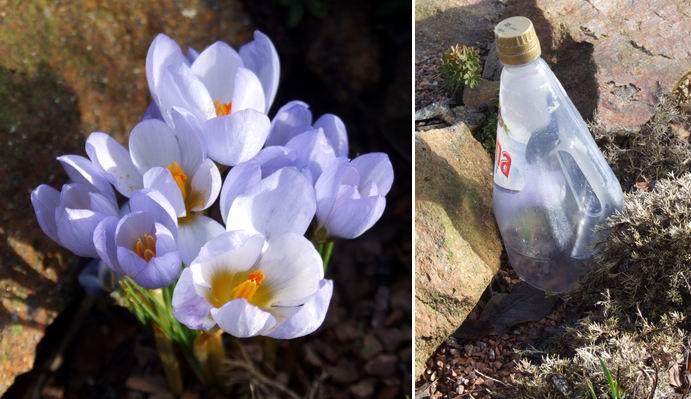
Crocus abantensis
There are many crocus and narcissus in full flower at the moment, displaying their beauty to the world but it is all in vain as I have not seen any pollinating insects at all. This means if you want seed, and I do, then we have to become the pollinator getting our paint brushes out and transferring the polling from anther to stigma. Another factor that affects whether we get a good seed set or not is the temperature. The pollen requires a certain temperature for it to grow down the tube from the stigma to the ovary. That is why I have placed this cut off plastic bottle over the Crocus abantensis growing in the raised bed in the hope that the temperature under the cover of the bottle will be a few degrees higher and allow the embryo seeds to be fertilised.

Crocus etruscus
The magnificent display of a crocus with its flowers opening to the sunshine would surely attract many insects if they were around but in the artificial environment of our gardens, where these plants have been moved thousands of miles from their native habitat, the insects are just not always around at flowering time. I also wanted to draw you attention to the 'beard' in the throat of Crocus etruscus. In the enlarged image you can see the hair like area just at the mouth of the throat, where the petals turn into the tube. The presence or absence of this beard is often used by the taxonomists in distinguishing between species and the technical term is pubescent when it is hairy and glabrous when there are no hairs.

Aphids on crocus leaves
We have to be ever alert to aphids in our bulb houses as they can appear at any time. Even a slight rise in temperature when the winter sun shines on the glass can cause them to become active. What we must remember is that since I sprayed, two weeks ago with a systemic insecticide that protects the bulbs that were in growth then, many more bulbs have put up their leaves, so I need to be continually spraying the new growths to provide them with the same protection. Of course you can argue that if it is to receive the fatal effect of the systemic insecticide the aphid first has to suck the sap from the leaves and then the damage is done as any virus could have been spread into the plant. The simple fact is that aphids will always be there and what we need to do is to keep them to a minimum but to allow them to slowly build in numbers at this time of year is a big mistake. I am often asked where do they come from this early in the year? Above is a pot of Crocus banaticus which normally stays in an outside frame
- I brought it under glass last autumn when it was in flower. I am convinced that the aphids climb down the stems and leaves of the bulbs as they go dormant where they lay eggs or hibernate in the bulbs. This is why I recommend that you also spray with a systemic insecticide just before the leaves die back as I have found that this greatly reduces this early emergence of aphids. This pot having been in an outside frame did not get that treatment last year and hence this early infestation.

Narcissus eualbidus
Among my favourites of all the narcissus we grow is this wee beauty. While not an official name, Narcissus eualbidus is how I received it and that is good enough for me especially when you see the confusion that exists in the nomenclature of the bulbicodium/cantabricus narcissus.

Narcissus asturiensis, Picos de Europa
Of all the trumpet daffodils my favourites are these very short forms of Narcissus asturiensis - this one was collected in the Picos de Europa and is only 4cms tall.

Frit house
Every day more fritillaries are pushing through the gravel surface as their growth
starts to extend rapidly - these also need the insecticide treatment. I have also been watering directly into the pots as the plants need plenty of moisture to fuel this rapid cell growth. I always try and water on a bright clear, mild morning when there is no forecast of frosts but this is not always possible and it is often the case that the night after I have watered we get a hard frost. Provided the frost does not stay around during the day no harm is done and I have to balance that against the harm that could be done to the bulbs if they get too dry at this stage of their growth. This is just one of the problems of growing bulbs in our very swinging winter/spring climate.
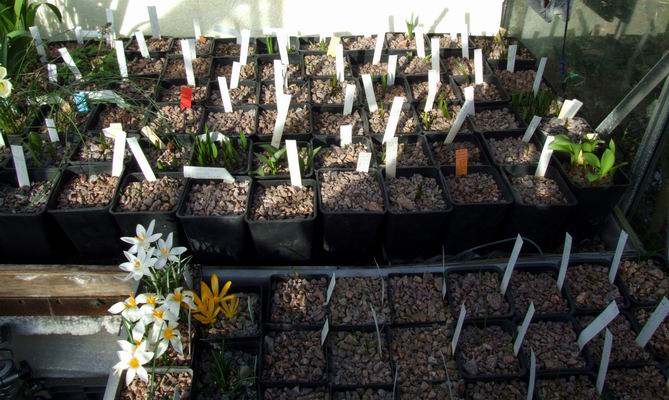
Frits in plastic pots
The frits in plastic pots are also emerging but, unlike the clay pots, these still retain plenty moisture so I can hold off watering these for a few days yet. There is a very fine balance at this stage between not enough moisture and too much.
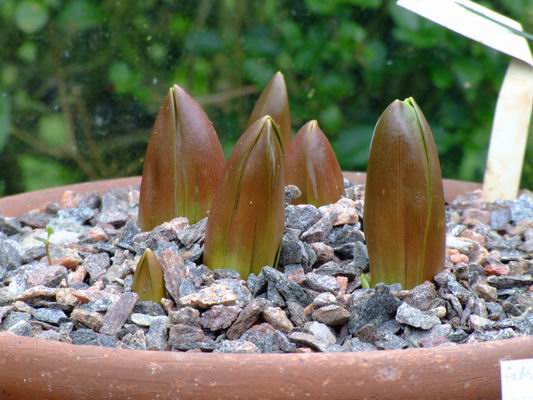
Fritillaria sewerzowii
Fritillaria sewerzowii is among the ones we still grow in one of the bigger clay pots and its emerging buds are nice and fat.

Fritillaria yumiensis
Fritillaria yumiensis is very decorative even at this stage with its acuminate leaves looking very attractive in profile.
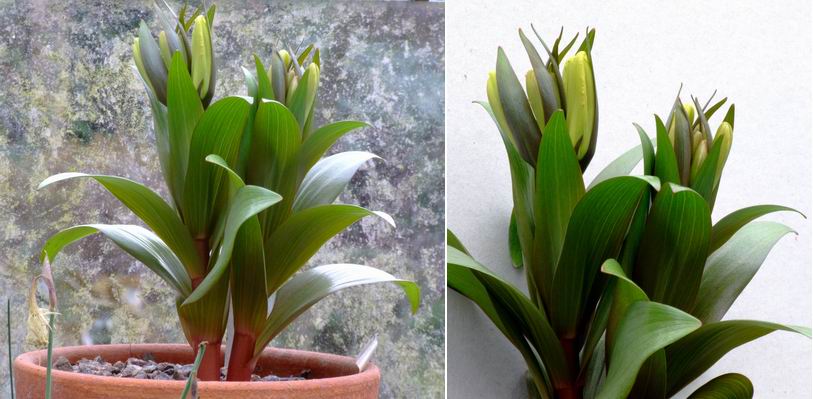
Fritillaria chitralensis
The big news for those of you who have been following the bulb log since it started, is that our Fritillaria chitralensis has sent up two flowering stems this year, each has six flower buds on so we are in for a real show in a few weeks time.

Eranthis 'Guinea Gold' and Crocus gargaricus
I was going to end the log with this picture of Eranthis 'Guinea Gold and Crocus gargaricus glowing in the dying rays of the afternoon sunshine as if they were light bulbs. But the artic winds have swept back over North East Scotland and we have a good covering of snow so I will finish with a couple of pictures of the now "back to wintry" scene in the garden.
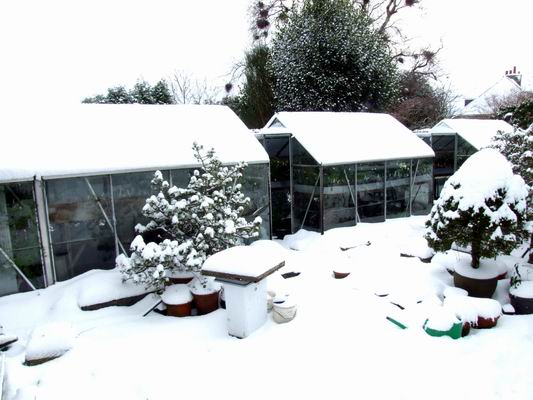
Snow arrives

Snow catcher
^ back to the top ^
|

